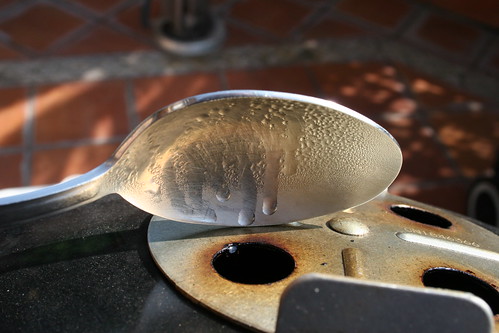Yesterday, I did another brisket which came out pretty well. I have been using Aaron Franklin's method for cooking brisket and I thought I would share my experiences with the group. I typically use choice packers.
1. Trim the fat to about 1/4".
2. Use 50/50 coarse ground pepper and kosher salt as a rub.
3. Foil over the water pan and preheat the WSM to 250F.
4. Let the brisket come to room temperature. Place the brisket fat side up on the grate next to a disposal loaf pan filled with water. Smoke with your favorite wood until you until reach an internal temperature of 165F.
5. At 165F first check the bark to make sure it is solid, nice color, and well set. If the bark is good, spritz the brisket with a 50/50 mix of water and worcester sauce and then triple wrap in 40 pound, food service grade, pink butcher paper. I have been using 18" width and now see a real need to go to 24" width.
6. Maintain 250F and starting checking for done at 190F internal temperature. Done means the brisket feels soft and pliable through the paper. You could also check for done by carefully unwrapping the brisket and poking it with a thermometer probe but if you are doing things right the paper is going to stick to the very carmely and sticky bark. I have tried this way and only succeeded in shredding the paper. Instead, I do the probe test by pushing a bamboo skewer through the paper. If the brisket needs to go longer, I seal the hole with a stack of three small pieces of butcher paper soaked in a little vegetable oil.
7. When the brisket passes the probe test in the flat, let it rest wrapped up at room temperature for an hour before slicing for service or holding.
8. My WSM is 20+ years old with a Cajun Bandit door, compression latch, and a HeaterMeter ATC (no gaskets). With all the accumulated gunk, the new door, and the new latch, my WSM is pretty tight. If I need to hold the brisket for a while before I serve it, I can crank the WSM down to 160F, hold that temperature (please note that your mileage may vary), and use it like a holding oven. At Franklin BBQ, the briskets come off the smoker at 1:30 AM and once they are rested at room temperature, they are held in an Alto Shaam holding oven until the restaurant opens at 11:00 AM. That long hold does not seem to hurt the quality of his product and may actually help it.
-- Mache
1. Trim the fat to about 1/4".
2. Use 50/50 coarse ground pepper and kosher salt as a rub.
3. Foil over the water pan and preheat the WSM to 250F.
4. Let the brisket come to room temperature. Place the brisket fat side up on the grate next to a disposal loaf pan filled with water. Smoke with your favorite wood until you until reach an internal temperature of 165F.
5. At 165F first check the bark to make sure it is solid, nice color, and well set. If the bark is good, spritz the brisket with a 50/50 mix of water and worcester sauce and then triple wrap in 40 pound, food service grade, pink butcher paper. I have been using 18" width and now see a real need to go to 24" width.
6. Maintain 250F and starting checking for done at 190F internal temperature. Done means the brisket feels soft and pliable through the paper. You could also check for done by carefully unwrapping the brisket and poking it with a thermometer probe but if you are doing things right the paper is going to stick to the very carmely and sticky bark. I have tried this way and only succeeded in shredding the paper. Instead, I do the probe test by pushing a bamboo skewer through the paper. If the brisket needs to go longer, I seal the hole with a stack of three small pieces of butcher paper soaked in a little vegetable oil.
7. When the brisket passes the probe test in the flat, let it rest wrapped up at room temperature for an hour before slicing for service or holding.
8. My WSM is 20+ years old with a Cajun Bandit door, compression latch, and a HeaterMeter ATC (no gaskets). With all the accumulated gunk, the new door, and the new latch, my WSM is pretty tight. If I need to hold the brisket for a while before I serve it, I can crank the WSM down to 160F, hold that temperature (please note that your mileage may vary), and use it like a holding oven. At Franklin BBQ, the briskets come off the smoker at 1:30 AM and once they are rested at room temperature, they are held in an Alto Shaam holding oven until the restaurant opens at 11:00 AM. That long hold does not seem to hurt the quality of his product and may actually help it.
-- Mache
Last edited:


